by Sebastien Delprat
If you think about it, the answer to the question is not so obvious. Why? Because the definition of ‘espresso machine’ is not trivial. Especially since the term espresso is, by itself, a bit difficult to define. It is not as hard as trying to answer the question ‘Who invented the very first coffee machine?’, but still….
As you may already know, ‘coffee’ was at first a concept rather than a precise thing, as explained by Antoine Galland in his book De l’Origine et du progrès du café, dating back to 1699:1
Hence, you see that pronouncing ‘Café’ as the Italians do, and as most of the nations of Europe do, we have made the first syllable short, and changed the ‘u’ of the second to an ‘f’, and that ‘Café’ and ‘Cahveh’ come from ‘Cahouah’, which is an Arabic word.
This word ‘Cahouah’, to speak of its meaning, comes from an Arabic verb, which means to have a disgust for eating, to have no appetite; and it is one of the different names that the Arabs give to wine, according to the richness of their language.2
Indeed, in Arabic, the word cahouah first designated a category of beverages that extended to wine. When the word was imported, altered, and adopted in Europe, it came to mean the coffee bean and the beverage derived from it, whatever the preparation method. Hence, if we look through time, the definition (and the taste) of coffee has evolved, and from an historical point of view, a concept (or a taste) is something very difficult to catch.
To some extent, so goes the notion of espresso….
What is called ‘espresso’ today was first called crema di caffè, and espresso now has a very precise definition. According to the Italian Espresso National Institute, it is 7 ± 0,5 grams of coffee extracted at 88 ± 2°C and 9 ± 1 bar3, filling a 50- to 100-mL cup with 25 ± 2,5 mL of liquid in 25 ± 5 seconds. In light of that definition, the answer to ‘Who invented the espresso machine?’ is almost obvious: Achille Gaggia invented that process during World War II, relying on an idea from Antonio Cremonese (who also invented the grinder with a doser).
But, over time, espresso came to designate a variety of beverages. It evokes the beginning of an era when the coffee machine took a prominent place on the bar counter and became part of the decorum, with a barista (or machinista, or limonadier) preparing coffee behind it, like a little ‘scénette’.
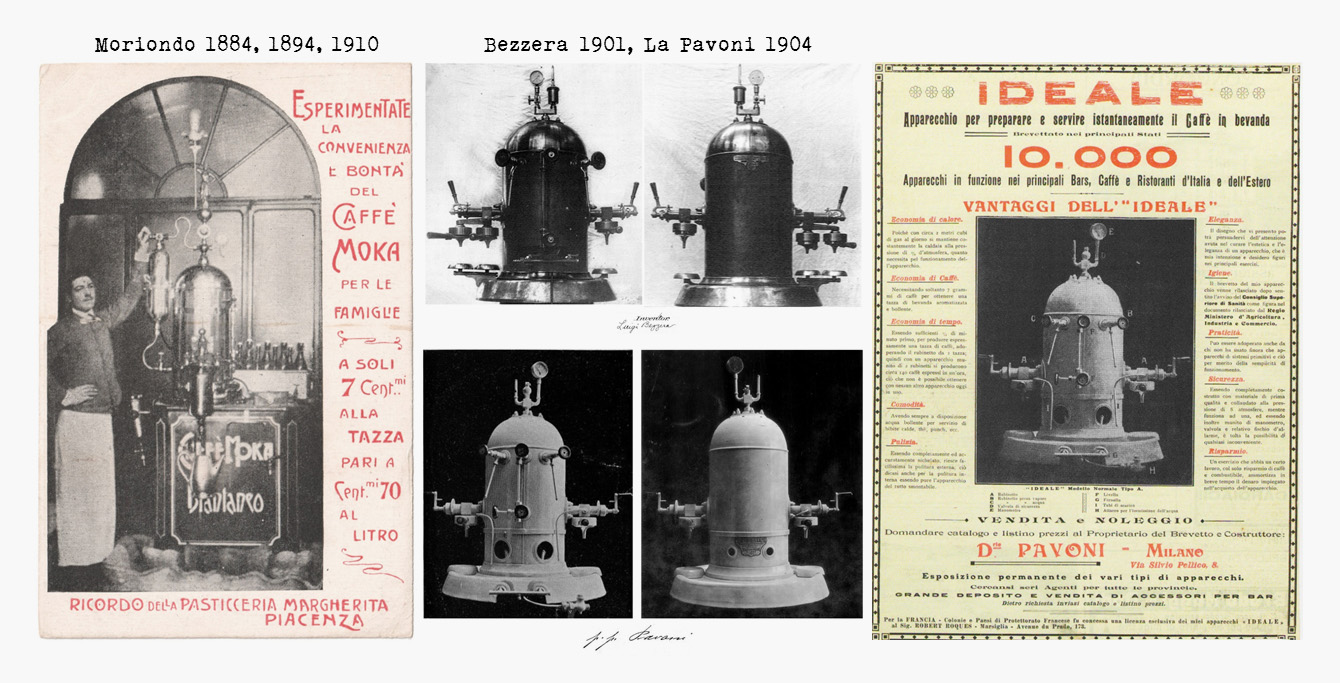 The very first photographs of espresso machines: (l–r) from Moriondo; from Bezzera; and the best known of them all, the Ideale model from La Pavoni
The very first photographs of espresso machines: (l–r) from Moriondo; from Bezzera; and the best known of them all, the Ideale model from La Pavoni
Desiderio Pavoni’s 1906 Milan Fair stand, at which he presented the 1901 invention from Luigi Bezzera, featured the words ‘Espresso Caffè’ in huge letters. Back then, and up to the 1950s, espresso designated the extraction of 6 to 7 grams of a not-so-fine coffee grind over 45 seconds, at 3/4 to 1 bar pressure and a temperature slightly above 100°C (necessary because the pressure was steam generated). The volume extracted was close to 60 mL (serving cups at that time were the size of teacups). This resulted in a coffee flavor similar to that of a brew prepared from a moka pot such as a Bialetti or ‘like a V60 brew but with more body’ (as Paul Pratt mentions in his La Pavoni Ideale extractions tries).4
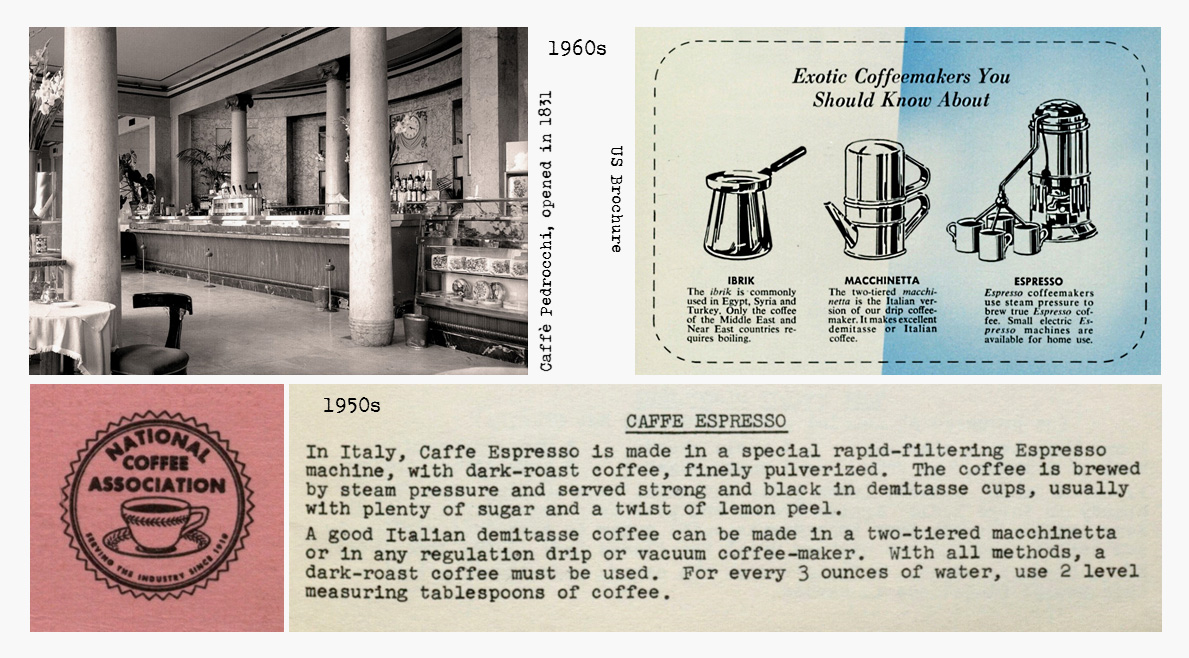 The interior of one of the oldest caffès in the world (Caffè Pedrocchi in Florence, Italy) during the 1950s, with a Gaggia lever machine on the counter; examples of brochures from the 1950s–60s mention espresso coffee
The interior of one of the oldest caffès in the world (Caffè Pedrocchi in Florence, Italy) during the 1950s, with a Gaggia lever machine on the counter; examples of brochures from the 1950s–60s mention espresso coffee
We know from Ian Bersten5 that this extraction method and Bezzera’s machine style had been, in fact, created by Angelo Moriondo in 1884. Later investigations confirmed that assertion6, and Moriondo is nowadays commonly considered to be the inventor of the espresso machine. Despite the myth saying that he made machine only for his own hotel restaurant7, one can argue that he was producing coffee beverages on demand but in large quantities and not ‘expressly’ for a single customer.
That ‘expressly’ is sometimes cited as the etymology of the word ‘espresso’. The reality is that neither Moriondo nor Bezzera used the word espresso or express. In their time, the beverage was called caffè in bevanda, with an emphasis on the instantaneity of the process, or sometimes caffè istantaneo (which has a very different meaning today).
Their patents were titled, respectively, ‘Nuovi apparecchi a vapore per la confezione economica ed istantanea del caffè in bevanda, sistema A. Moriondo’ (1884) and ‘Innovazioni negli apparecchi per preparare e servire istantaneamente il caffè in bevanda’ (1901). In 1906, La Pavoni used the title ‘Apparechio per preparare e servire istantaneamente il caffè in bevanda’ to describe his Ideale machines. Bezerra’s patent mentions that his apparatus could produce coffee for a single cup, but it is not part of the official claims.8 Moreover, José Molinari (who was undoubtedly Moriondo’s partner in Spain) filed a patent in 1894 titled ‘Un procedimiento para la confeción del café en bebida por medio de la presión del vapor y filtración instantaneá para el consumo en pequeñas ó grandes cantidades’, proving that Moriondo’s system was also intended for producing small quantities.
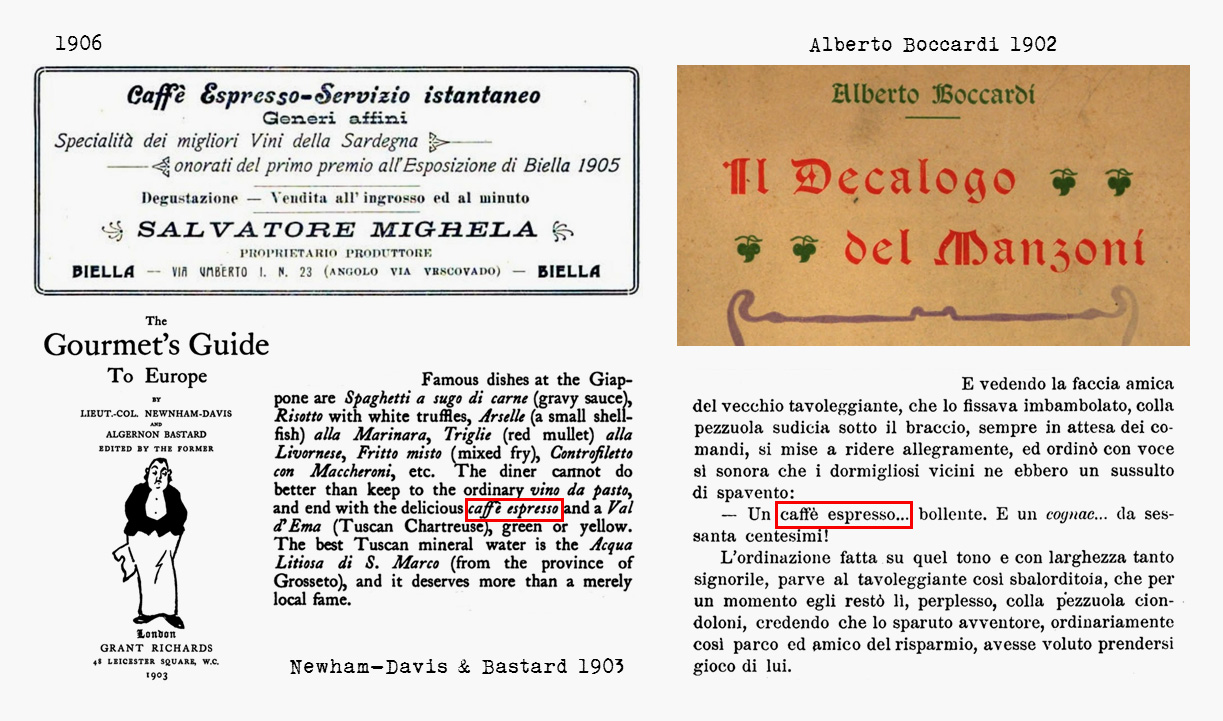 An advertisement from 1906 and extracts from The Gourmet’s Guide to Europe (1903) and Il decalogo del Manzoni (1902) mentioning ‘Caffè Espresso’
An advertisement from 1906 and extracts from The Gourmet’s Guide to Europe (1903) and Il decalogo del Manzoni (1902) mentioning ‘Caffè Espresso’
In French, espresso was called expresso or café express. During the 1880s, there was even a company in Paris making dry and sweetened coffee extracts called ‘Express-café’ (from Barotte, Meyer & Cie). Expresso, in that sense, was understood to be a liquid that expresses the full aromatic potential of the coffee bean.
But more likely, the term espresso has more to do with the search for quickness, or ‘expressness’, of on-demand extraction. Expresso is certainly a derivative of express, in reference to the express trains of the same era, because of the fast brewing time and the use of steam in the process. William H. Ukers, in his famous reference book All About Coffee, published in 1922,9 does not use the word expresso or espresso. Rather, he describes the new product from Italy as ‘rapid coffee’ (produced by rapid-filtration or rapid-infusion machines).
As I searched for early mentions of the word, I found one in a book from a famous gourmet and critic, journalist George Augustus Sala (see right side of the illustration below). He tells that, in Florence, caffè expresso stands for a strong coffee with lots of sugar. Apparently, that was still the case in the 1950s, since The National Coffee Association (from the US), described a caffè espresso as a demitasse (60 to 90 mL) of strong coffee brewed by steam pressure from finely ground dark-roast coffee, ‘usually with plenty of sugar and a twist of lemon peel’.
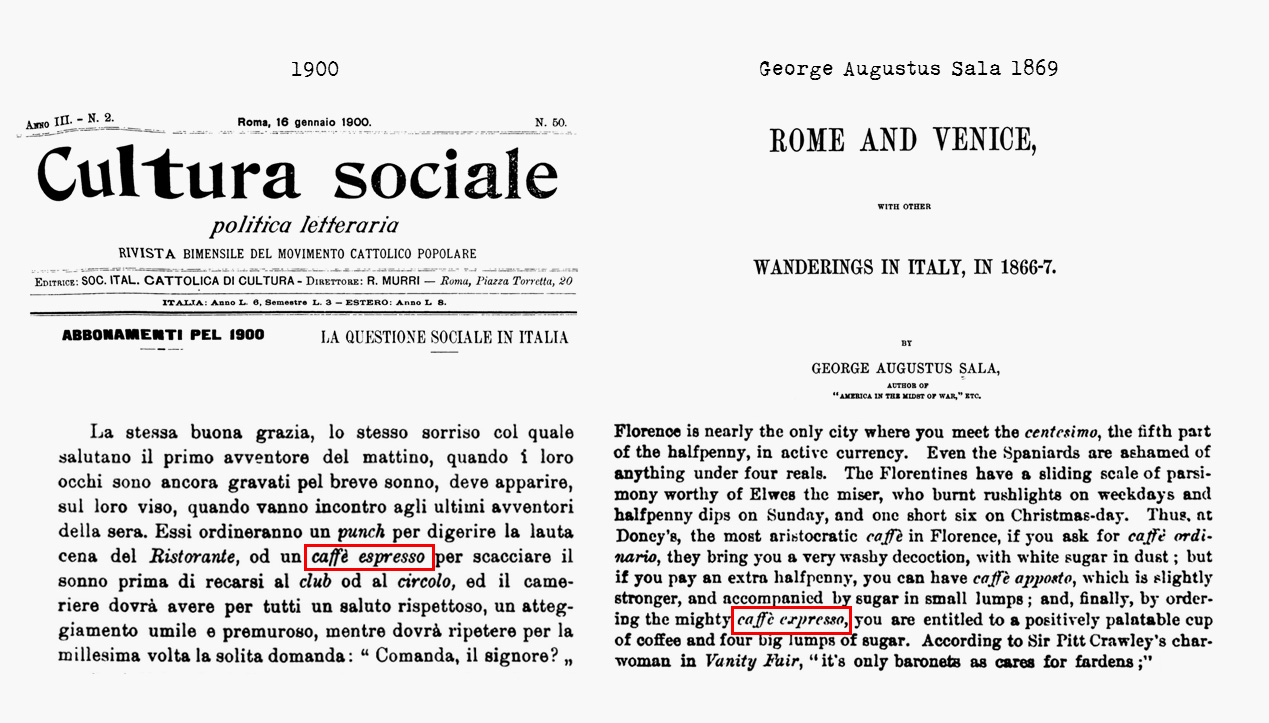 Extracts from the journal Cultura sociale (1900) and from the book Rome and Venice with other wanderings in Italy in 1866-67 (1869) mention caffè espresso and expresso.
Extracts from the journal Cultura sociale (1900) and from the book Rome and Venice with other wanderings in Italy in 1866-67 (1869) mention caffè espresso and expresso.
So … it is important to note that the origin of the expression caffè espresso is not clear and, for sure, it was used to name very different beverages—ranging from a strong coffee made from extracts or by hot water forced through coffee by steam pressure, sometimes spiced or flavored, to an extraction made in very precise conditions in order to produce a natural cream on top of it (la crema di caffè). How, then, can we determine who was the inventor of such a moving concept? Indeed, there will be as many inventors as there are definitions of the word. The common ground is that, as the consumers’ tastes evolved, caffè espresso was always used to designate a strong beverage, made rapidly.
Oh, and did I mention that Sala’s book was published in 1869? That’s years before Moriondo! How can that be?
In fact, research for extracting the full potential of coffee beans in the shortest time possible began a long time before Moriondo was even born. After testing the use of gravitation, hydrostatic force, a vacuum, and so on, steam pressure appeared to be the most promising way to achieve that goal. Moriondo’s machine was simply the ending point of that quest, in almost all its aspects.
If we rely on the authority of available patents, the principle of using steam to push water through ground coffee is certainly a German invention, dating back to 1818. Elard Römershausen, a great inventor and precursor at that era, built giant apparatuses to produce coffee extracts, some of which used steam force.10 In the same time period, Louis Bernard Rabaut (a French engineer who emigrated to England) was the first to apply, in 1822, the same principle to a smaller coffee maker. Following in his footsteps, André Caseneuve (1824), Edouard Doublet, and Pierre-Isidore Rouen (1833), from France, followed by Samuel Parker (1833), from England, improved on the original invention and ended up with a machine that closely resembled the moka pot. A reference book from 1845, Nouveau manuel du limonadier, du chocolatier et du confiseur, shows that this type of coffee maker was popular in the mid-nineteenth century, along with ‘Du Belloy’ and vacuum-type coffee pots.
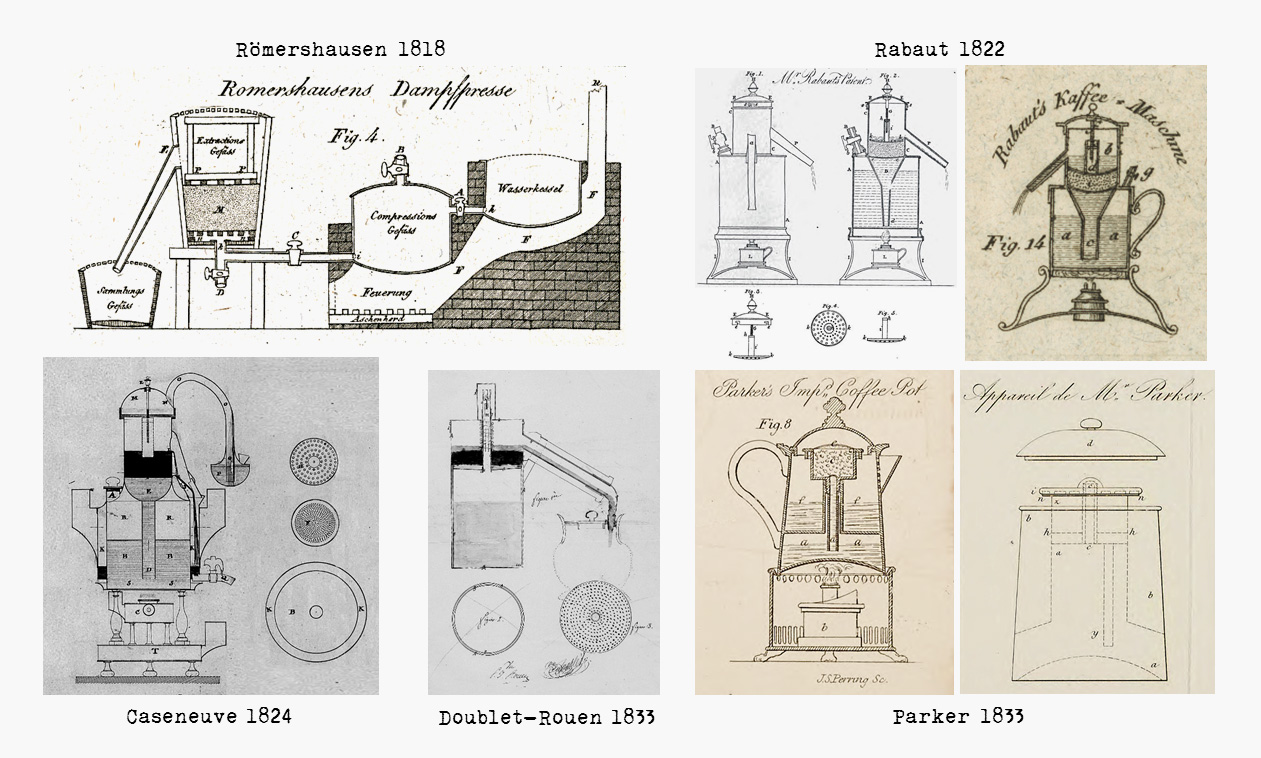 Inventions related to the use of steam pressure to extract coffee, 1818 to 1833
Inventions related to the use of steam pressure to extract coffee, 1818 to 1833
We are looking for inventors of a concept that is still in use today (or that is well known in history), and some are very hard to find: for example, who invented the moka pot? Was it Rabaut (who first applied the principle to home use) or Parker (who thought of a practical way to recharge the dose of coffee and keep the beverage inside the pot)? Was it Bialetti, who popularized it so much that he has its name attached to it, or was it somebody else who never patented his or her invention?
Tough call.
The same goes for the espresso machine, even if we restrict the definition to the concept of making single cups of coffee, for many customers, as quickly as possible. It is difficult to define who invented the machine that included a boiler, a group, and a portafilter to quickly recharge coffee between shots (respectively named ‘donkey boiler’, ‘feeding cock’, and ‘filter-support’ at first), since the transition in technology from the time of Römershausen to the time of Moriondo was quite smooth.
1Everybody should read this small book published more than 300 years ago, in which (among other interesting information) Antoine Galland debunks the legend of Kaldi the goatherd, which is still widespread in the coffee world.
2The original text reads: ‘Ainsi, vous voyez qu’en prononçant Café comme les Italiens, et comme la plupart des nations de l’Europe, nous avons fait la première syllabe brève, et changé l’u de la seconde en f, et que Café et Cahveh viennent de Cahouah, qui est un mot arabe. Ce mot de Cahouah, pour parler de sa signification, vient d’un verbe arabe, qui signifie avoir un dégoût de manger, n’avoir point d’appétit; et c’est un des différents noms que les Arabes donnent au vin, suivant la fécondité de leur langue.’
3I might add ‘a pressure induced by the freshly ground coffee itself’, hence requiring a fine and homogenous grind (and excluding Nespresso and other automatic robot technology from that definition).
4See his impressive Ideale restoration thread on Home-Barista.
5‘Coffee floats, Tea sinks’, Ian Bersten (1994)
6‘La Victoria Arduino, 100 anni di caffè espresso nel Mondo’ by Franco Capponi (2005) and my own articles on ‘Ascenseur pour l’Expresso’ (episodes 9 to 11, 2014–2015) and ‘In search of Moriondo’s espresso machine‘ on Home-Barista (2018)
7See my previous article on the Barista Hustle website; ‘Angelo Moriondo: The Myth of the Selfish Barista’ (2021).
8On a patent document, the claims appear at the end of the document and explain the limits of what a patent covers.
9All About Coffee, William H. Ukers (1922)
10He also experimented with other forces to do so, such as a vacuum and a mechanical crank. See Ascenseur pour l’Expresso, Episode 3 (2013) for more details.



0 Comments